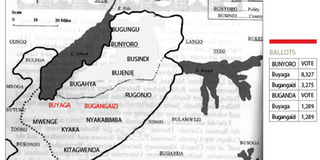The referendum on the Lost Counties

Map of bunyoro showing Buyaga and Bugangaizi - the lost counties earlier given to Buganda. COURTESY MAP
What you need to know:
Buganda banked on their king and President Muteesa, as well as his alliance with Obote’s UPC to keep its token counties, but when the ballot was cast- Buganda’s hope on Buyaga and Bugangaizi counties was cast away.
Kampala.
In the article on the ‘lost counties’ of Bunyoro, we indicated that its was agreed at the Constitutional Conference in London in 1962 that “after not less than two years, the National Assembly shall decide on the date for a referendum - in which the people of the counties will say whether they prefer to be in Buganda or Bunyoro, or remain under the Central Government.”
Much as this was clearly spelt out in the Constitution, the leadership of Buganda initially did not believe that the referendum would be held.
It was assumed that Obote would not carry out the referendum. They thought the alliance -between Obote’s UPC and Kabaka Yekka- could break the law of the land. Also, because of its superior position in Uganda affairs, the Baganda assumed nothing like that could happen. This false assurance was based on the fact that UPC was in alliance with Kabaka Yekka.
There was some remote logic in this reasoning. As long as the government of the day was an alliance between UPC and KY, it was initially difficult for UPC to get the enabling legislation to carry out the referendum.
The politics
However, as a result of non-UPC Members of Parliament crossing over to the UPC, Obote increasingly acquired the necessary parliamentary strength to pass the legislation. By the middle of 1964, he felt strong enough to begin settling the issue of the ‘lost counties’ with or without the approval of Buganda.
At this point the Kabaka’s ministers found themselves in a dilemma. They could not accept that the referendum would take place because this would mean accepting that in principle, part of Buganda’s territory could be transferred. On the other hand, delay in campaigning would lead to loss of valuable time.
“They were beginning to suffer the consequences of their early short-sightedness, dithering and complacency,” observed Professor Hancock in his article, Buganda Crisis, 1964.
They were under the illusion that the Ndaiga Scheme- set up in 1963 as a device to make double sure Buganda did not lose the “lost counties”, was working as planned.
It was believed that one of the best ways to retain the lost counties was to develop the area. That is to say, the Banyoro were to be persuaded to stay in Buganda because there would be economic and social advantages.
Simultaneously, a parallel measure to increase Ganda population in the area through settlement was to be carried out. Under the scheme, more than 4,000 men were settled in the area. Most of these people were kawonawos or returnees from the Second World War.
In the early part of 1963, Kabaka Muteesa established a hunting camp at Ndaiga, a place close to the shores of Lake Albert. Reports have it that the camp was built by some 150 kawonawos. After a brief return to his palace at Mengo, the Kabaka returned with a further 300 kawonawos.
On August 25, the Minister of Justice moved the following motion: “Resolved that this House, in accordance with provisions of paragraph (a) of sub-section (1) of section 26 of the Uganda Independence order in council 1962, do hereby appoint the day 4th November 1964, as the date on which the referendum to ascertain the wishes of the inhabitants of the counties of Buyaga and Bugangaizi, as to the territory in which each of the two counties should be included, shall take place.” Although during the debate, Kabaka Yekka Members of Parliament walked out, the Bill received support from both sides of the House.
Paulo Muwanga, a UPC backbench member and a Muganda, scoffed at the KY walk-out. He told them the remedy for any aggrieved members was to go to court. Muwanga’s views were endorsed by C.J. Magara who was representing Bunyoro South West. The Bill was passed on August 28.
The Bill provided that only those registered to vote in the counties in 1962 would be eligible to vote. This provision was aimed at excluding the Baganda ex-servicemen who the Buganda administration was settling into the area under the so-called Ndaiga Scheme intended to influence the results of the referendum.
“There was one sticky issue; a Bill passed by parliament does not automatically become law. The last stage in the process of legislation requires that the assent copy of the Bill be signed by the President, which is still the case with the 1995 constitution,” Baganchwera-Barungi tells us in his book, Parliamentary Democracy in Uganda: The Experiment That Failed.
“Sir Edward Muteesa’s position was not only curious but ambivalent. He was both the KABAKA OF BUGANDA and THE PRESIDENT OF UGANDA. Few expected him to give consent to the Referendum (Buyaga and Bugangaizi) Act of 1964. Here was a typical example of conflict of interest. There was no way the Kabaka of Buganda could sign away part of the ‘territory of his kingdom’ and yet legal requirements of the constitution had to be fulfilled.
It was incumbent upon the Clerk to the National Assembly to ascertain whether or not the President would attach his signature. The arduous task of submitting the assent copies of the Act fell on the author who was then the officer in charge of that schedule of duty. He also happened to be a son of the soil of Bunyoro Kitara kingdom, which was claiming the counties of Buyaga and Bugangaizi--an unenviable situation. The author had on previous occasions performed this duty with ease devoid of any apprehension. However, on this occasion, he did not feel comfortable because the political climate was tense and charged with a looming sense of insecurity.
Eventually I found myself face to face with the President. The venue was the presidential lodge at Makindye in the suburbs of Kampala. When I drove into the compound of the lodge, I could barely see anybody around. The place was quiet, but suddenly an officer appeared on the scene and directed me to the outside shelter where I found his Excellency, the President dressed in army uniform. He was alone. After preliminary curtseys, I proceeded to present three copies of the Assent Act.
True to Kiganda tradition, he did not offer me a seat, but since I was there on the service of the government of Uganda, I decided to ignore that tradition and pulled a chair. I waited quietly for his reaction--after some time the response came, ‘these are difficult days, I have to consult one or two persons’. That was the last time I spoke to Sir Edward Muteesa II in his capacity as President of Uganda. In the end, the Prime Minister signed the assent copies of the Act. In anticipation that Sir Edward Muteesa would decline to sign the Assent copies of the Bill, legal steps had been taken to enable the Prime Minister to do so,” Baganchwera-Barungi explains.
Following this, both Buganda and Bunyoro went into heavy campaigns to woo the residents to their side. Of the two pratagonists, Buganda clearly had a more difficult task. The census returns of 1959 had provided some evidence that the Banyoro were in the majority in the two districts.
The Molson Commission which had been tasked to advise the British government on the dispute between the Kingdoms of Buganda and Bunyoro over the ‘lost counties’ had also concluded there was a Banyoro majority in the two counties and had gone on to even recommend that the two counties be turned over to Bunyoro.
It is estimeted that Buganda spent more than 30,000 pounds in the campaigns. On the other hand, Bunyoro - with a smaller economy and much more chances of winning did not take things lightly. On October 22, it made provision to spend 18,619 pounds of which 10,000 pounds was set aside to cover what was called gifts.
When votes were cast and the results declared on November 5, the ‘lost counties’ found their way back home in Bunyoro.




